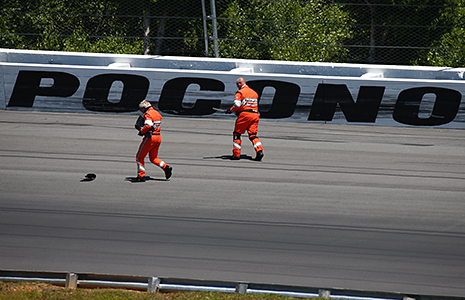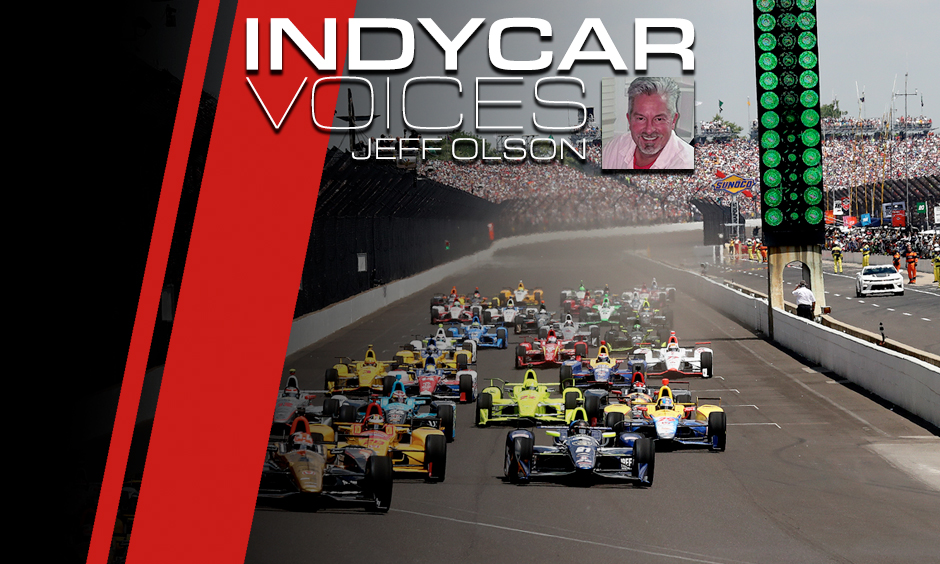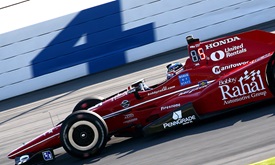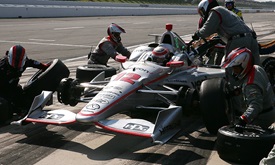INDYCAR's 'guardian angels' quietly shine on Pocono weekend
AUG 22, 2017
For many, the best part of the ABC Supply 500 was a finish that separated the top four drivers by 0.8770 of a second. Or the cat-and-mouse between teammates Will Power and Josef Newgarden during the final laps. Or a lead change summary so exhausting that it ended on the back side of the box score.
All appropriate measures of a race, no doubt. But at Pocono Raceway, the best part of the race weekend occurred during the worst part. It involved sprinting, skill, organization and professionalism. And sacrifice.
Even before Ryan Hunter-Reay’s car slid to a stop Saturday following the sickening thud of a hard crash in Turn 3, two men in orange jumpsuits were sprinting toward it. A truckload of them arrived seconds later. They surrounded the car’s cockpit, carefully helped Hunter-Reay get out, then helped him as he limped to a waiting vehicle that took him to the infield care center.
 By now, you know how this story ends. Hunter-Reay sustained an injury similar to a hip pointer. Painful and limiting, certainly, but not bad enough to prevent him from racing the next day. He raced, of course, and put his name on that crazy long lead change summary (three times for 12 laps) before finishing eighth. He even made the back of the page for leading Laps 151 through 153.
By now, you know how this story ends. Hunter-Reay sustained an injury similar to a hip pointer. Painful and limiting, certainly, but not bad enough to prevent him from racing the next day. He raced, of course, and put his name on that crazy long lead change summary (three times for 12 laps) before finishing eighth. He even made the back of the page for leading Laps 151 through 153.
As impressive and worthy as that effort was, the praise for it goes to a safety crew that doesn’t seek praise (or money or fame or anything else) for what it does.
“The speed that they get to us is one thing, but how much they care and how much pride they take is another,” Ed Carpenter said after Sunday’s race. “They bring new guys in as other guys get older, but at the same time it seems like some of these guys have been doing it forever. Being around them and seeing how hard they work, you realize that when you’re in a position like that, you know you’re being taken care of.”
Carpenter was one of three drivers assisted by the Holmatro Safety Team during Saturday’s practice and qualifying sessions. He crashed during practice; Helio Castroneves and Hunter-Reay crashed during qualifying.
Like Hunter-Reay, Castroneves had the wind knocked out of him and needed a moment to catch his breath. Unlike Hunter-Reay, he didn’t require a hospital visit. Minutes before Sunday’s race, Castroneves applauded the safety team.
“I call them our guardian angels,” he said before driver introductions. “For them to be there in less than 10 seconds in an accident like that is the difference between an injury and possibly a fatal accident.”
For James Hinchcliffe, it was the difference. His crash at Indianapolis Motor Speedway in 2015 has become the standard by which racing safety crews are measured. A piece of the car’s front suspension pierced the tub and penetrated Hinchcliffe’s thigh. They had seconds to get him out of the car, stop the bleeding and save his life. And they did.
Days later, at the Indianapolis 500 awards banquet, Hinchcliffe sent a video thank you. The crowd responded with a standing ovation. Not for Hinch, but for the people who saved his life.
"It’s incredible to me that, for as dangerous a sport as we participate in, we can so often confidently strap into our cars, pushing the danger to the back of our minds,” Hinchcliffe said in the video. “That is largely due to the fact that we know just how good hands we are in.”
That’s what we do know. What we don’t know is the depth of the details. This doesn’t come by chance; it’s practiced. Many are EMTs and firefighters in their daily lives, all experienced in emergency rescue.
Upon reaching the car, each worker has a specific assignment. They’re fully versed in the details and quirks of the cars. They carry equipment specific to the cars and the type of emergency they’ll encounter.
But they also take the time to know the drivers. In turn, the drivers trust them.
“The continuity of that whole system has been in place for so long,” Carpenter said. “For all the leadership changes in INDYCAR in the last 15 years, they’ve been a constant. They’ve made it through every transition because they’re the best of the best.”
The best of the best amplifies the best of humanity. Most people react to danger and trauma by avoiding it. Few get involved. But people who devote their lives to helping others in severe and immediate trouble are all around us. Firefighters, police, EMTs, trauma doctors and nurses – the list is extensive and essential.
They don’t seek publicity. They don’t seek glory or riches. They seek only to perform the task at hand as professionally, quickly and effectively as possible. They seek only to save other humans.
Often, we see the crash but not the rescue. Once the driver is out of the car, we exhale and move on. We don’t notice the depth of the planning of the rescue, the communication or the choreography. We don’t see the selflessness. We don’t see the importance. We don’t see the goodness.
Often, the most significant part of racing – and the most significant part of life – isn’t what we see. It’s what we overlook.




















